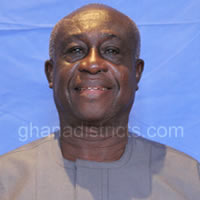Governance
The Bosomtwe District Assembly is a statutory body established by the Local Government Act 462 of 1993 and it is the highest policy- making body of the District representing the entire political and administrative machinery of the Central Government at the District level. The Assembly is made up of the District Chief Executive as the political head, the Presiding Member, who is the Chairman of the General Assembly, one person from each of the 35 electoral areas within the district, elected by the universal adult suffrage, 15 Appointees of the Government, Heads of the decentralized departments who are ex- officio members without voting rights. It is supported administratively and technically by 11 departments of the assembly and other quasi agencies of government. The relationship between the Assembly and these departments is consultative as shown in the organogram in Figure 1.17 and Figure 1.18.
Departments of the Assembly
Legislative Instrument (L.I) 1961 identified 11 departments for district assemblies which include:
• General Administration
• Finance
• Education, Youth and Sports
• Agriculture
• Physical (Spatial) Planning
• Social Welfare and Community Development
• Natural Resources Conservation, Forestry, Game and Wildlife Division
• District Health Department
• Works
• Industry and Trade
• Disaster Prevention
Staffs of the departments are the technical officers of the Assembly providing the required technical expertise for local level development. Departments of the Assembly are headed by Heads of Departments who are responsible for efficient and effective performance of the functions and responsibilities assigned to the departments.
The Bosomtwe District Assembly does not have the full complement of staff yet, as the Natural Resource Conservation Department do not exist in the district. The Department of Trade and Industry is yet to be established, however, the Assembly has the presence of the Business Advisory Centre (BAC) and the Co-operative in the district
Independent Governance Institutions existing in the district include:
1 Electoral Commission (EC)
2 Commission on Human Rights and Administrative Justice (CHRAJ)
3 National Commission for Civic Education (NCCE)
Sub-District Structures
The District Assembly has three (3) Area Councils and 35 Unit Committees which facilitateeffective communication between the Assembly and the local people. The Area Councilsoversee the activities of the Unit Committees as well as assisting the Assembly in theadministration of the Area Councils. The three (3)Area Councils are:
Jachie Area Council
Kuntanase Area Council
Boneso Area Council
The offices of the Area Councils are located at Jachie, Kuntanase and Bonkorkor respectively
The sub-structures are functioning as personnel have been posted to man the offices. Furniture has also been provided to all the Area Council offices as well as computer and accessories except the Boneso Area Council which does not have a computer and accessories. The District Assembly has again ceded the following revenue items to the Area Councils to collect. They include:
1. Basic Rate/Development Levies
2. Burials, Funerals, Funeral decorators, Vault with structures and suoer structures excluding home burial.
3. Toilet Operations
4. Urinals Operations
5. Dislodgements (Private Operators) and dislodgement vans and conveyance charges
6. Refuse sites and dumping sites charges
7. Night sellers
8. Pounds/ Stray Animals
9. Sand wining conveyance charges (excluding granting of permit)
10. Palm Wine, Pito Brewers etc.
11. Hawkers
12. Pet/ Dog, Cat License etc.
13. Mills
14. Artisans/ Self Employed
15. Block/ Pavement/ Culvert etc. manufactures
16. Hiring of sound systems
17. Exportation Fees
18. Cultural displayed groups (NwomkroKete, Adowa etc)
19. Illegal Felling of Trees (fines)
20. Hiring of Canopies and Chairs
21. Business Service Providers
22. Private Cocoa Buyers/Dealers
23. Mobile Sales vans i.e. Medicine Food, Float, Adverts etc.
24. Public Grounds hiring and road/ street block and diversion.
25. Utilisation of Public and social blocks for Activity i.e. Church services, weddings, meeting etc.
26. Birth and death registration for certificate
NB: Registration, Licenses, granting of approvals and Permits for the first time for all these activities will be done by the Assembly through the sub structure. All items not mentioned here are not ceded.
Cultural/Traditional Set Up in the District
The district has one paramountcy, Kuntanase Traditional Council. The seat is currently vacant following the death of the paramount chief. The District has 13 divisional chiefs (Abrempong). They are custodians of lands in their respective jurisdictions. Apart from ensuring the physical development of their respective areas, they also serve as arbitrators in their areas of jurisdiction. Most people channel their grievances through the Traditional Authorities instead of coming to the District Assembly. Though there is a sub chief at Apinkra, he owes allegiance to the Ejisu Traditional Council. Also, the Obbo/Krom Adwafo chief owes allegiance to Kokofu Traditional Council in the Amansie East Municipal Assembly. Almost every community in the district has a queen mother. The queen mothers are about 50 in number.
The sacred/taboo days are Tuesday and Fridays. These days are mostly used for communal labour and other social activities since farming is prohibited on those days.Communal spirits in most of the communities have dwindled and there is the need to revive the enthusiasm to facilitate development in the district. The chiefs in the district also recognize other sacred days like Akwasidae, Awukudae and Fofie. The people do not undertake farming activities in these days.However, the chiefs and people of Woarakose celebrate “Kohwe kose Festival” in the last week of January to the first week of February every year, where puberty rites (Bragoro) is performed.
Funeral celebration is one aspect of life that the people pay serious attention to, due to the high reverence the people give to the dead. They are celebrated on Thursday and Saturdays.
The District has more than eight ethnic groups which includes Akan, Ga Adangbe, Ewe, Guan, Mande, Gurma, Mole Dagbani and others. Akan is the predominant ethnic group with 88.5 percent and the others with 11.5 percent (2010, PHC).The major religion in the Bosomtwe District is Christianity with 85 percent followed by Islam (4.7%), traditional (1.3%) and others (11%). There are no serious negative cultural practices in the District. Ethnic conflicts are uncommon; however, there are few chieftaincy conflicts in some parts of the District. Notable communities are Kuntanase, Aputuogya, Pipie.
Accountability
As an institution, the District Assembly should be accountable to the people it serves. The electorate should therefore, demand accountability from the officials of the Assembly and the Assembly members. Hence, officials and Assembly members must cultivate the culture of openness and transparency in the award of contracts for the construction of projects, collection of revenue, purchase of equipment, machinery and stationery and the distribution of development programmes and projects within the district. To be accountable to the people as well as being open and transparent in all its transactions, the District Assembly has put in place some structures. These structures include;
• District Tender Committee
• Tender Evaluation Committee (Adhoc Committee)
• Budget Committee
• Monitoring and Evaluation Team and others
These structures help to promote transparency, openness and accountability in the transactions of the District Assembly.
Participation of Citizenry
Participation in development programmes by the local people is very crucial in order to ensure successful implementation of these programmes. The participation and engagement of citizens in decision-making is the hallmark of democracy. Ghana has adopted and is committed to decentralization as the surest way to achieve the dual benefits of increased participation of citizens in governance, as well as engendering stable and resilient local communities
In almost all the activities of the Assembly apart from the Assembly members and Unit Committee Members, beneficiary communities, C.B.Os, C.S.Os and NGOs are involved annual budget preparation, all stakeholders like the GPRTU, Trade Associations ,operators of restaurants, barkeepers, beauticians and other identifiable bodies are made an integral part of the discussion. They express their opinions on the rates and fees to be charged in the incoming year. By so doing, they make important inputs into the budget. The citizenry are also involved in programmes and projects implementation. The chiefs, opinion leaders and unit committee members of beneficiary communities are involved in meetings, projects inspection, monitoring and evaluation. To inform the people on the activities and performance of the Assembly so that they in turn can express their views on the activities of the Assembly, particularly on issues that border them, public hearing and peoples assemblies are organized in the district at some communities. The people are then given the opportunity to participate in the administration of the Assembly.
Again through their elected representatives at the Assembly, some community members are able to express their views on pertinent issues like the armed robbery and environmental sanitation in the district. Some NGOs, particularly World Vision International has always been in partnership with the Assembly in their development agenda in the district. The District Assembly thus, coordinates the activities of the CBOs, NGOs and CSOs in the district.
Current State of Citizenship Participation in District
• Public hearing after data collection and analysis
• Public hearing after draft development plan
• Public hearing on Composite Annual Action Plan and Composite Budget
• Town hall meetings and community meetings
• Radio discussion/phoning on implementation of projects
• Dissemination of Annual Progress Report
• Notice Boards – DA and Sub-Committee meetings, Revenue Charts, Announcement of Jobs, Appointments, Procurement Notice/Request for Quotations), Procurement Awards and Annual Accounts
• Area Council and Unit Committee meetings
• Stakeholders/Rate Payers Fee-Fixing consultation
• Participatory monitoring of projects
• Information sharing
Application of Communication Strategies
It is not enough to collect and collate information from the populace. It is also important that proposals, policies and programmes are also sold out to the general public. One effective way to reach out to people and the communities for their input into the development agenda of the district is through public hearing and discussions. From 2014 up to 2017, the Assembly has organized not less than twelve (12) of such public hearings in various communities in the district..The strategy yielded positive response from the various communities and Area Council as the people lauded the programme and made healthy contributions to the plan. Other communication strategies that are used by the Assembly to reach out to the people and to also receive healthy responses include seminars, workshops, interviews and radio discussions. They are adopted by the Assembly to sensitize and to receive responses from the populace
Date Created : 11/18/2017 3:23:29 AM





 facebook
facebook X (twitter)
X (twitter) Youtube
Youtube +233 593 831 280
+233 593 831 280 0800 430 430
0800 430 430 GPS: GE-231-4383
GPS: GE-231-4383 info@ghanadistricts.com
info@ghanadistricts.com Box GP1044, Accra, Ghana
Box GP1044, Accra, Ghana